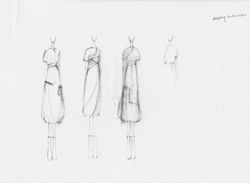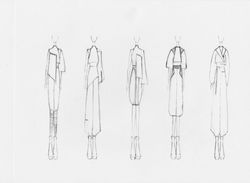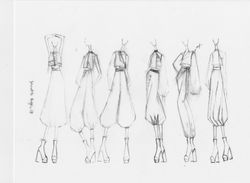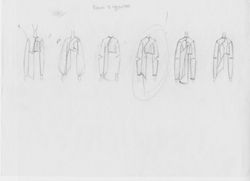
Into the Wind
In the modern world where being surrounded by technologies could not make it up for the lack of human interactions, there were people who felt lonely and decided to go back to Mother Nature to recover peace within their mind. On this long, isolated journey, the wind was their loyal friend and at some point, they seem to have emerged into it.
This project won the Blance Payne Award from the International Textile and Apparel Association.

Collection moodboard



Final designs include two ensembles: 1. A crop-top and a pair of baggy pants; 2. A ponte dress and an over-sized jacket (illustrated above)
Silhouette: Over-sized/loose fitting asymmetrical garments with draping features bring out a "free", flexible feeling. A lot of asymmetric details are employed in the collection. Layers and draped features also play an important part in bringing movements into the garments.
Materials: Ponte, satin (wrong side), cotton, and suiting fabric
Color: Back, White, Navy, Silver (see mood board for the color inspiration)

Technical flats for 2 final ensembles

The grey crop-top has two layers connected to each other by ties. The left one overlaps the right and the neckline runs toward the connecting point of the two. The blouse features lantern sleeves, narrow cuffs, and an asymmetrical flat collar. I used light-weight grey suiting fabric as the main fabric and organza for the underlining.
The navy baggy pants features a high asymmetrical waistband and an invisible zipper. A bottomless pocket on the right side creates the illusion of layers.

The draped dolman sleeve and the right side of the black dress bring about a “free”, flexible feeling. Hand stitching and facing are used to finish the dress in order to maintain a clean look and provide balance.


The top part of the dress has two darts; one of them is transferred into the sleeve. A metal zipper runs along the right sleeve from the neckline to near center back. Fusible tricot is applied to some pieces and along the zipper line to create a smooth, sculptured look.

The lined white jacket features dropped shoulders and flat lapels. The outside layer is made considerably longer than the two beneath it. This layer continues to the back of the jacket to create an outer self-lined part, connecting to the bodice by the armhole seam. Along with white lining fabric, for this jacket I used wrong side of satin to take advantage of the smooth surface without the sheen.

Three front layers overlapping each other to close the jacket: two on the left side and one on the right side.
 |  |  |  |
|---|---|---|---|
 |  |  |  |
 |  |  |  |
 |